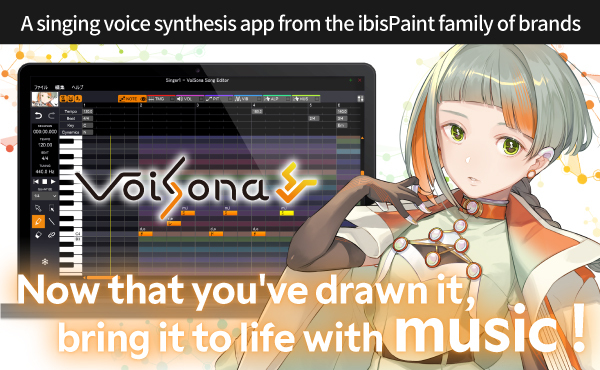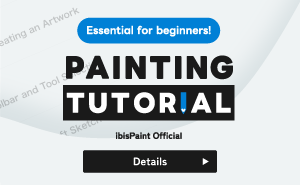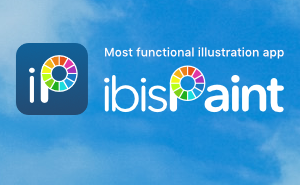Tutorials
171. Manga Function: Master the Manga creation tools
- Manga Function: Let's create a manga manuscript
- Manga Function: Master the Manga creation tools
- Manga Function: Make Use of Materials
- Manga Function: Publishing and Printing your Manga
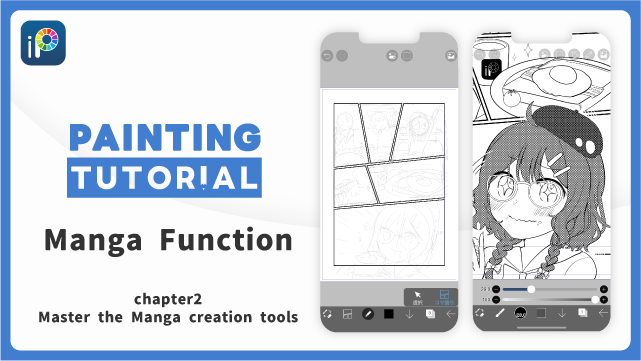
This chapter introduces useful tools that are essential for producing Manga. The “Frame Divider tool”, which allows you to divide frames with one finger, the “Text tool”, which allows you to choose a font, and “Screen Tone”, which can be pasted by painting, are just some of the functions necessary for Manga production that ibisPaint offers.
Frame Divider tool
Using the Frame Divider tool, you can easily create frames that are essential for Manga production.
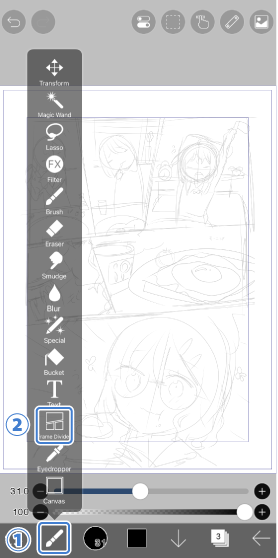
Open the ①[Tool Selection window], and select ②[Frame Divider tool].

Tap on the screen. Tap on ③[Add Frame] once it appears.
④[Horizontal Space] …You can adjust the margins on both the left and right
⑤[Vertical Space] … You can adjust the margins on both the top and bottom
⑥[Frame Thickness] … You can adjust the thickness of the frame
Once you are done adjusting, tap on ⑦[✓] to finish.
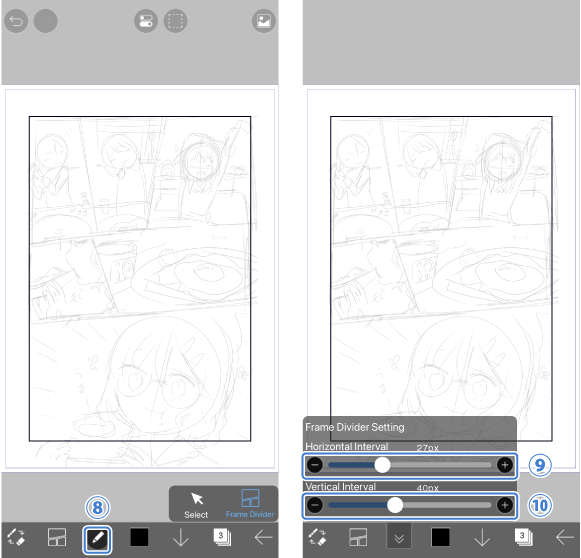
Now that the overall frame has been added, the next step is to divide it up. Adjust the spacing between the frames before dividing them. Tap the ⑧[Edit button].
⑨[Horizontal Interval]…Adjusting the spacing when dividing frames horizontally
⑩[Vertical Interval]…Adjusting the spacing when dividing frames vertically
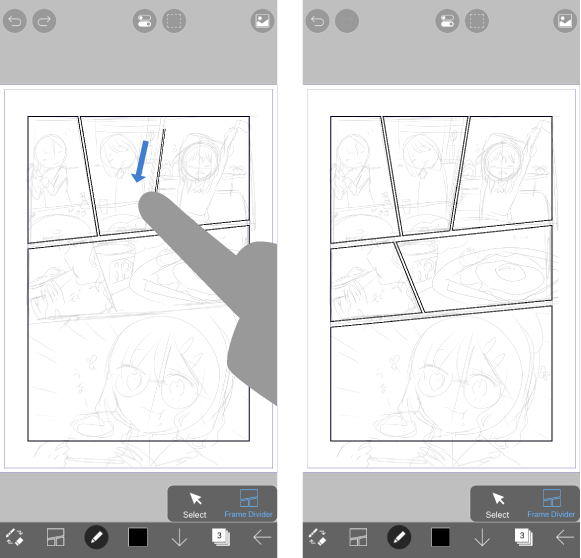
Divide the frames along the frames of your draft. You are done when all the frames have been divided.
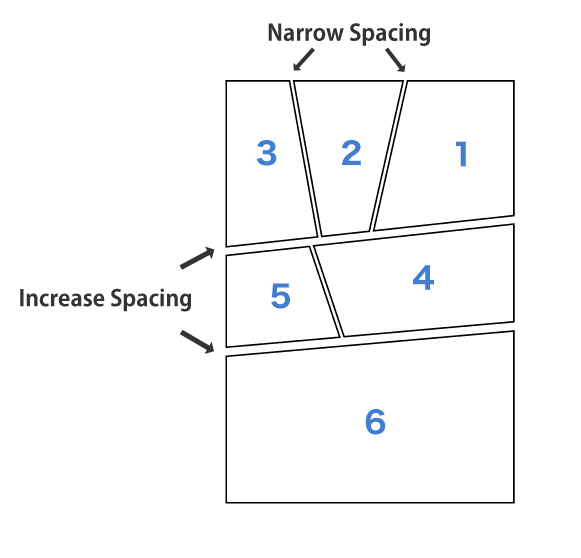
Manga is read horizontally, then vertically, so we recommend narrowing the space between horizontal frames and widening the space between vertical frames to make it easier for the reader to read.
Screen Tone
You can easily paste the Screen Tones used in Manga. By pasting Screen Tones, you can instantly improve the appearance of your Manga.
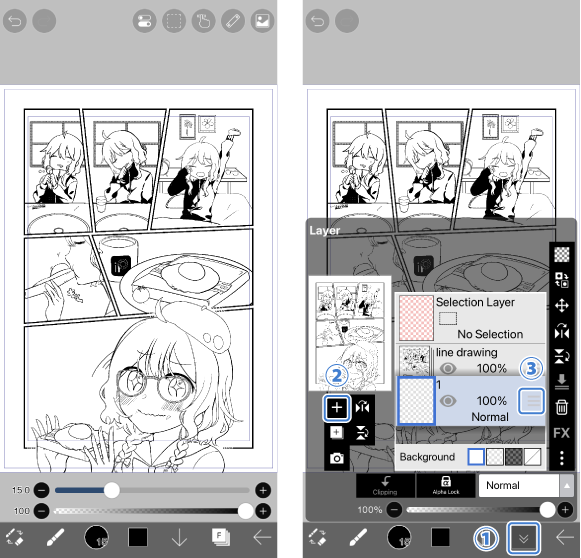
Prepare the line drawing which you want to paste the Screen Tone onto. Open the ①[Layer window], Add ②[a new layer], Drag the ③[current layer] underneath the line drawing.
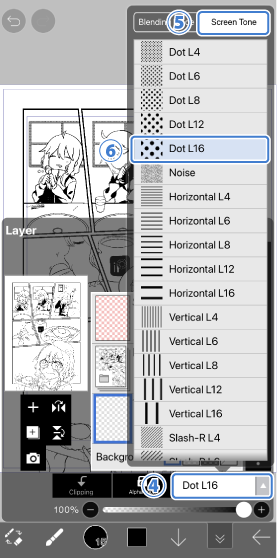
Select ④[Blending Mode] and tap ⑤[Screen Tone]. The Screen Tones will be displayed in a list, so select the one you want to use. Let’s use ⑥[Dot L16] as an example. (For Dot below Dot L8, Dot is fine and may smudge when printed. Therefore, for a printed draft, Dot L12 or Dot L16 is recommended.)
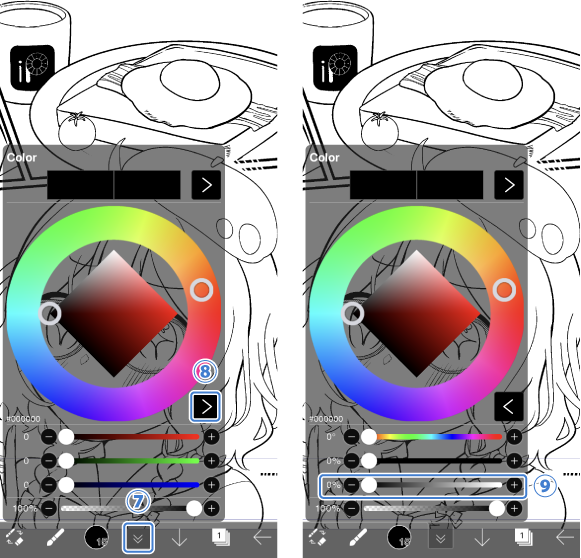
The density of the Screen Tone can be changed by changing the color density. Open ⑦[Color Palette] and tap the ⑧[HSB/RGB Toggle button]. Set it to black and move the ⑨[Brightness Slider]. In this example, we set it to 58%.

Paste the Screen Tone on the new layer created earlier.

We want the hat to be a little darker, so let’s set the ⑩[Brightness Slider] to 32% and paint it in.
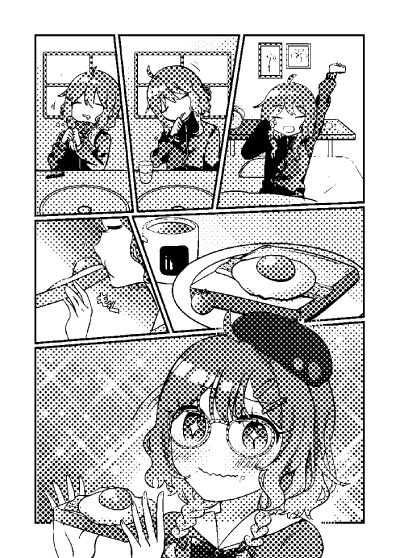
You are done once you paste the Screen Tone all over.
Radial Line Filter
This is a Filter that allows you to easily create Radial Lines to add impact to the frames of your Manga.
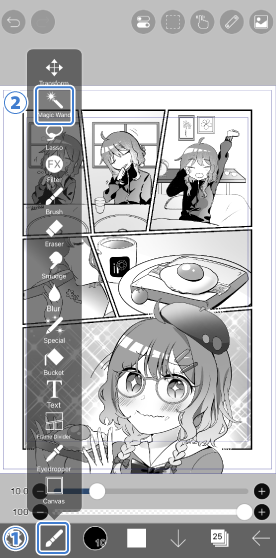
Open the ①[Tool Selection Window] and select the ②[Magic Wand tool].

Tap ③[% button]. Tap ④[Reset] to reset to the default value. Tap ⑤[Specific Layer] and choose the layer of your ⑥[Layer with drawn frames].
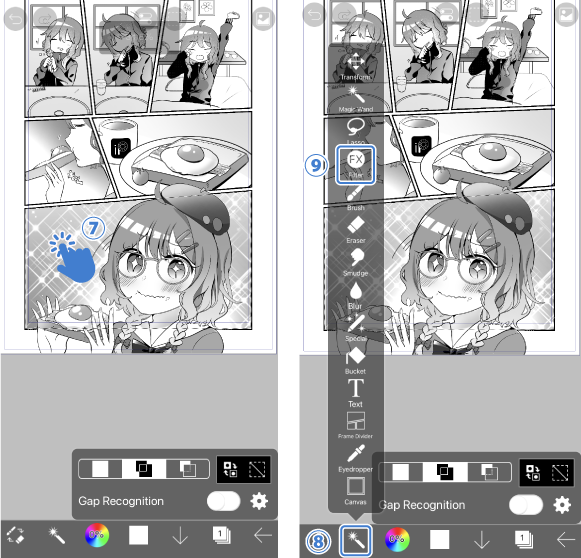
⑦[Tap] inside the frame where you want to insert Radial Lines. Since I set the frame's layer to Specific Layer, only the frame is selected. Select ⑨[Filter] from the ⑧[Tool Selection Window].

Select ⑪[Radial Line] from ⑩[Draw]. Drag the ⑫[Knob] to adjust the position. This time, We wanted to draw Radial Lines toward the center of the frame, so we moved the Knob to focus on the frame. Please adjust the shape of the Radial Lines using the ⑬[Slider]. When you have finished adjusting, tap ⑭[✓] to return to the Canvas.

Radial Lines were applied to create an impressive frame.
Click here for a video of the Frame Radial Line Filter
Click here for details on the Frame Radial Line Filter
Speed Line Filter
This is a Filter that allows you to easily create Speed Lines that give a sense of speed and dynamism to the frames of your Manga.
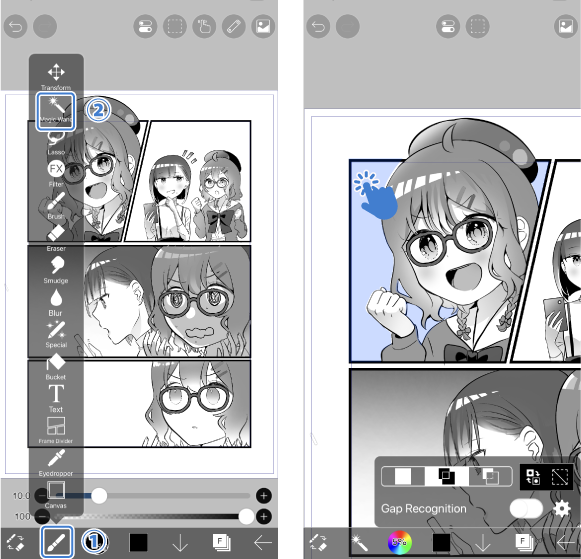
Open the ①[Tool Selection Window] and select the ②[Magic Wand tool]. Use the Magic Wand tool to select only the character's background. (For clarity, the selected area is filled in blue.)
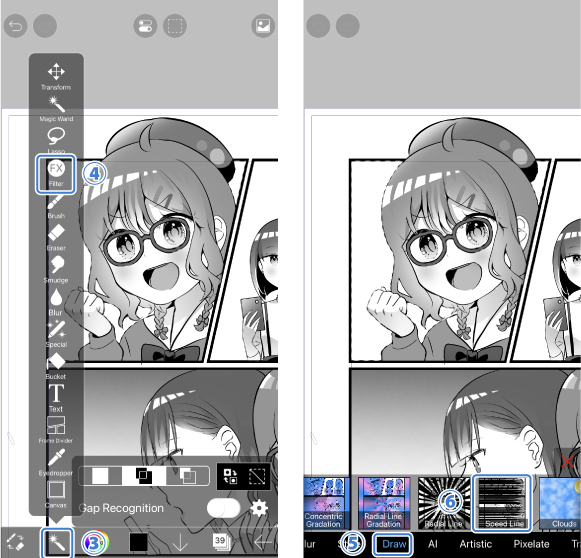
Once you have made your selection, select ④[Filter] from the ③[Tool Selection Window]. Then, select ⑥[Speed Line] from ⑤[Draw].

You can change the position of the Speed Lines by dragging the ⑦[Knob]. Please adjust the shape of the Speed Lines using the ⑧[Slider]. When you have finished adjusting, tap the ⑨[OK button] to return to the Canvas.

The Speed Lines have created a dynamic frame.
Outline Pen
You can easily create a Manga Balloon using the Outline Pen.

Customize Outline (Fade) a little to create Manga Balloon Pen and register it as a Custom Brush. Find ②[Outline (Fade)]in the ①[Brush Window] and tap ③[+].
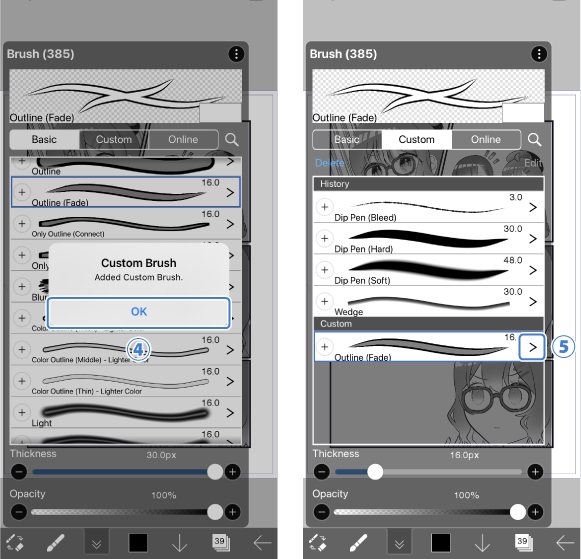
The selected Brush will be added to Custom Brush, so tap ④[OK]. Tap ⑤[>] to customize the Brush.
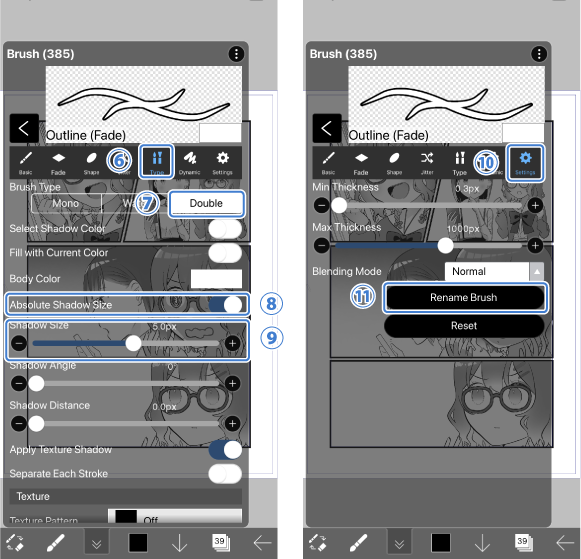
From ⑥[Type], select ⑦[Double]. Enable ⑧[Absolute Shadow Size] and choose the ⑨[Shadow Size]. We recommend around 5px. This time, we will register it as 5px. Next, rename the Brush. From ⑩[Settings], select ⑪[Rename Brush].
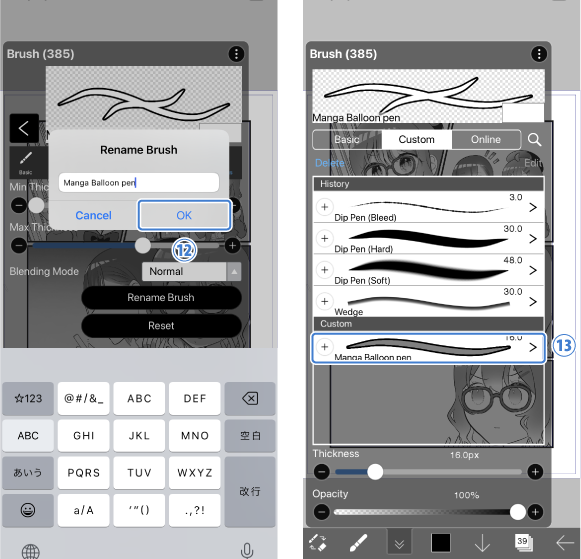
Enter the brush name. This time, as an example, we entered “Manga Balloon Pen”. Once you have decided a name, select ⑫[OK]. Now that we have created a Custom Brush, let's draw Manga Balloon using the ⑬[Manga Balloon Pen].

Manga Balloons have been drawn easily. If you feel that the borders are too thin or too thick, adjust the pixels (px) of “Shadow Size”.
Elliptical Ruler
By combining the Elliptical Ruler with the Brush Tool’s Wedge and Flash, you can easily create jagged Manga Balloons.

From the ①[Ruler tool], select ②[Elliptical Ruler].
Drag ③…change the width.
Drag ④…change the position.
Drag ⑤…change the height.
Drag ⑥…change the angle.

Once you have decided on the shape of the ellipse, open the ⑦[Brush Window]. This time, ⑧[Wedge] is selected as an example. After selecting the brush, draw a circle counterclockwise.
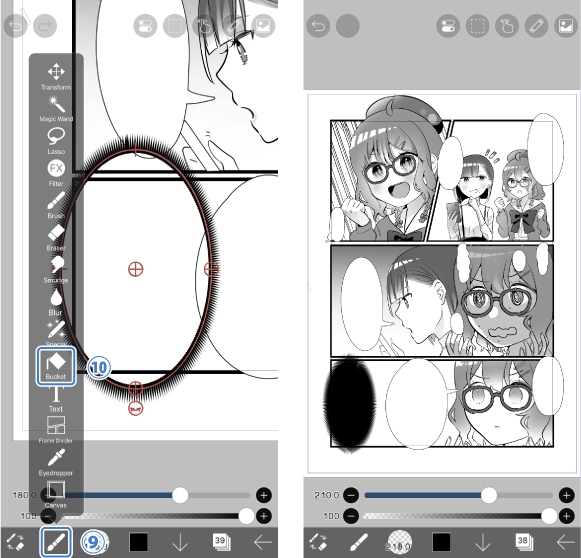
Open the ⑨[Tool Selection Window], select the ⑩[Bucket Tool], fill in the center, and it’s done.
Text Tool
You can easily add words using the Text Tool.
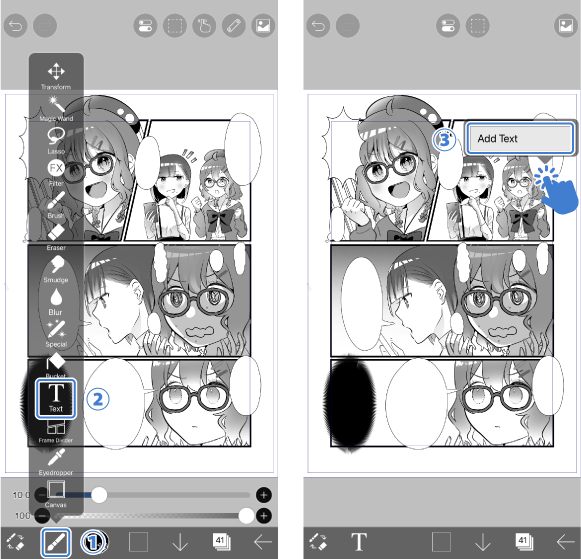
From the ①[Tool Selection window], select ②[Text Tool]. When you tap on the screen, ③[Add Text] will be displayed, so tap it.
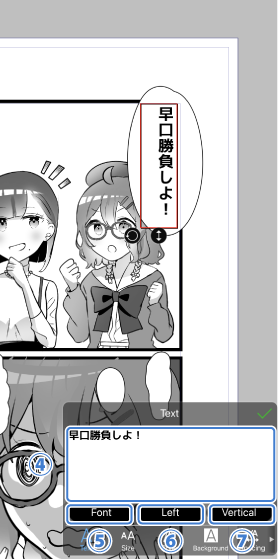
④You can enter characters in the blank field.
⑤You can choose the font.
⑥Tap to switch between [Left], [Center], and [Right].
⑦Tap to switch between [Vertical] and [Horizontal].
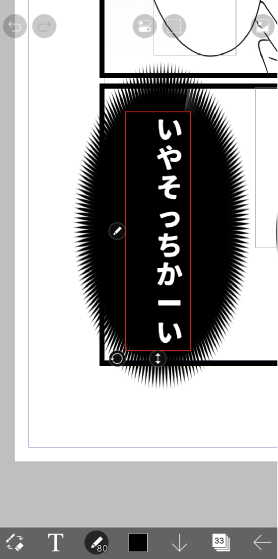
In the case of Vertical, depending on the font, long vowels in some languages may appear horizontal instead of vertical, as shown in the image above. This occurs when the font does not possess vertical writing information, so please try selecting a different font.

By adding text, it’s getting closer to completion.
Manga Background Filter
You can use the Manga Background Filter to process photos into a Manga-like background.

Prepare the image you want to use as the background of your Manga. Open the ①[Tool Selection Window] and select the ②[Filter].
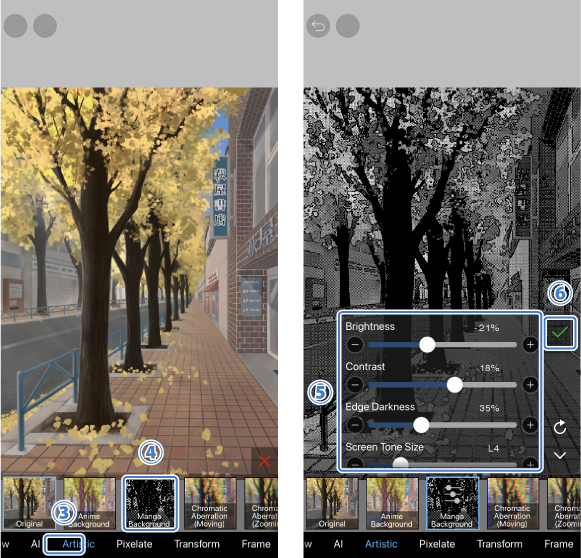
Select ④[Manga Background] from ③[Artistic]. Drag the ⑤[Slider] left and right to adjust the Contrast, Edge Darkness, Screen Tone Size, etc. When you have finished adjusting, tap the ⑥[OK button] to return to the Canvas.
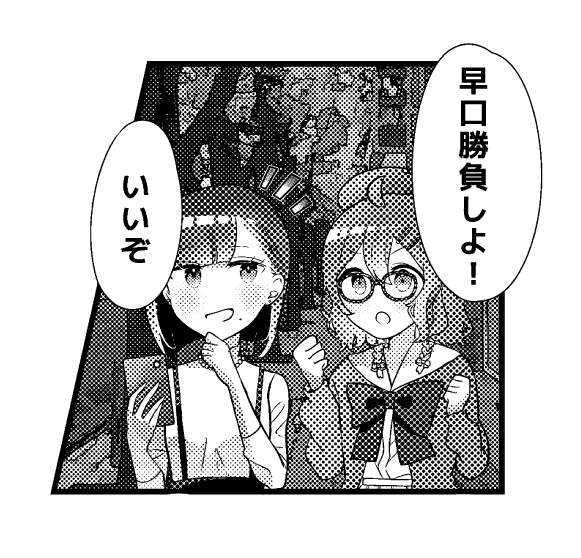
Place the background on the Manga frame and you are done. Even if you cannot draw backgrounds, you can use backgrounds created with this Filter in your Manga to instantly improve the level of completion.
Click here for a video of the Manga Background Filter
Click here for details on the Manga Background Filter
Perspective Array Ruler
The Perspective Array Ruler allows you to choose between One-point perspective, Two-point perspective, and Three-point perspective for an accurate perspective when drawing. This time, we will use the Perspective Array Ruler to draw a simple rectangular box in each perspective drawing method.
First, we will briefly introduce how to use the Perspective Array Ruler.
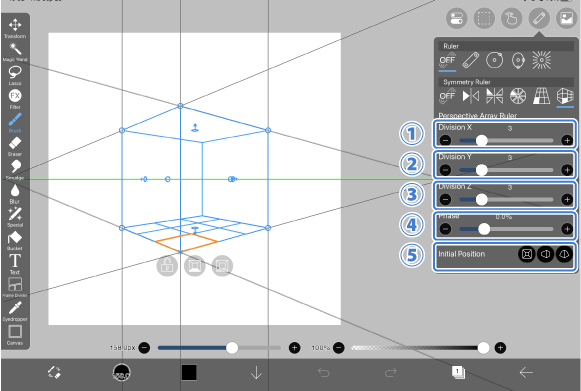
①[Division X]…Number of horizontal divisions
②[Division Y]…Number of divisions in depth
③[Division Z]…Number of vertical divisions
④[Phase]…Difference from the initial placement
⑤[Initial Position]…Selection of the perspective drawing method
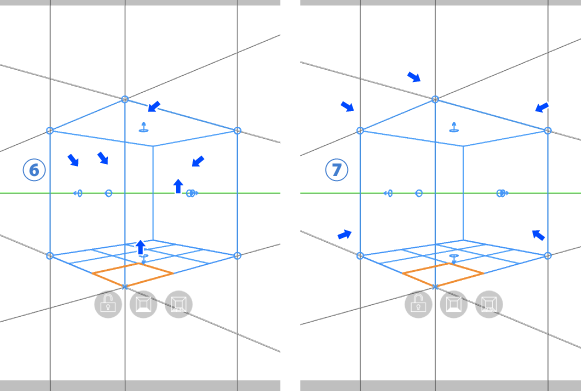
⑥[Face knob]…Adjust the position of the face by dragging
⑦[Vertex knob]…Freely transform the perspective by dragging
Please note that moving the Vertex knob may change the perspective drawing method specified with the Initial Position. If you want to return it to the original position, you can do so from Initial Position.

⑧[Lock button]…Makes the Perspective Array Ruler unable to be moved or transformed
⑨[Face Selection button]…Changes the reference face
⑩[Array Selection button]…Changes the work cell duplication destination
Now, let's draw a simple box using the Perspective Array Ruler.
Draw a box with One-point perspective
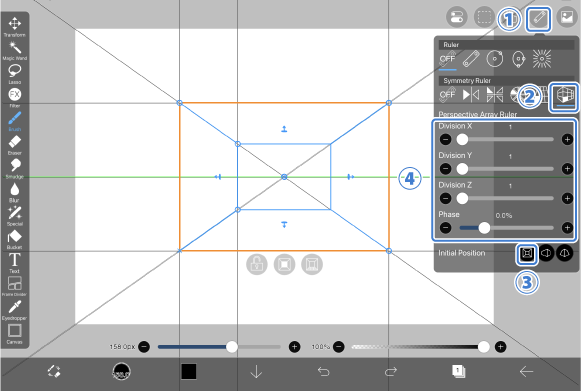
Select the ②[Perspective Array Ruler] from the ①[Ruler Tool]. From Initial Position, select the leftmost ③[One-point perspective]. The initial number of divisions is 3, but since we are drawing a box this time, set all ④[Division] except Phase to 1.
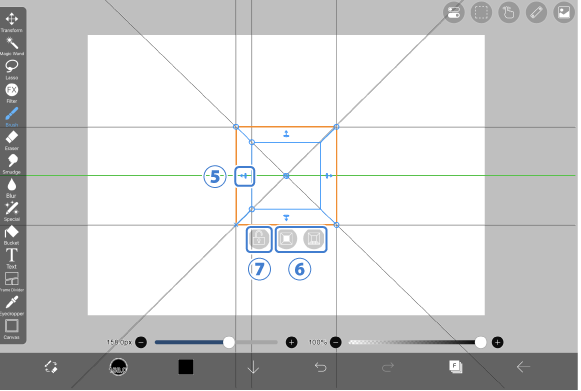
To draw a rectangle viewed from the front, first, drag the ⑤[Face knob] to decide the size of the rectangle. This time, we will draw it in a shape that is close to a square. Tap the ⑥[Face Selection button] to set the face to the front. Once you have decided on the shape, tap the ⑦[Lock button] to lock the settings of the Perspective Array Ruler.
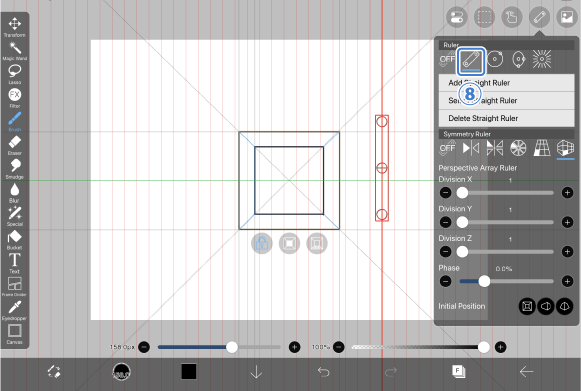
Draw the front face and the face that is the farthest in the back. Select ⑧[Straight Ruler] from the Ruler Tool. Draw a rectangle along the lines of the Perspective Array Ruler.
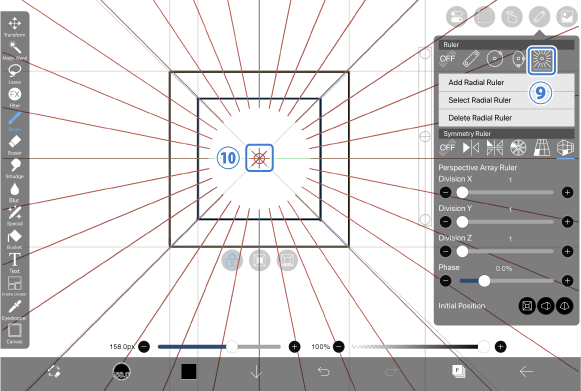
Now that we have drawn the front face and the farthest face, next, we will draw the depth. Select the ⑨[Radial Ruler] from the Ruler Tool. Place the Radial Ruler at the ⑩[vanishing point].
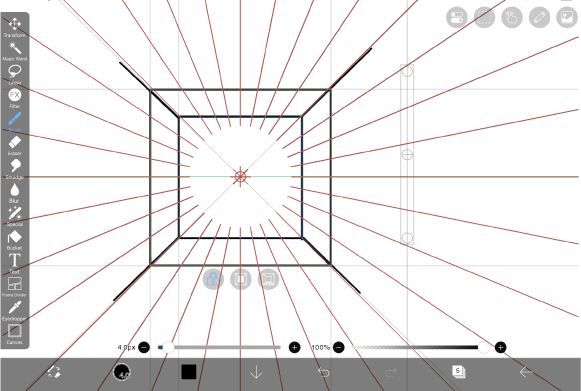
Draw lines connecting the corners of the front face and the farthest face. At this time, it is recommended to draw on a separate layer from the layer on which you drew the front face and the farthest face, as this will make it easier to erase the intersecting lines later.
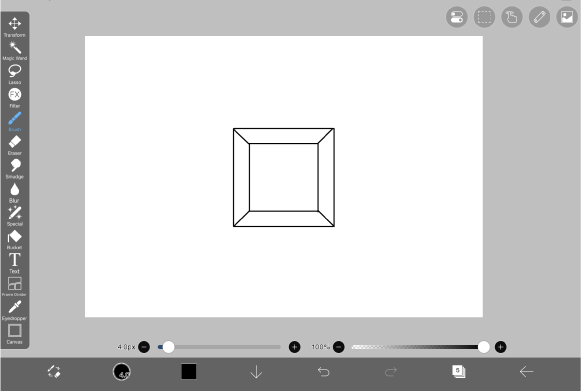
Finish up by erasing the extra lines.
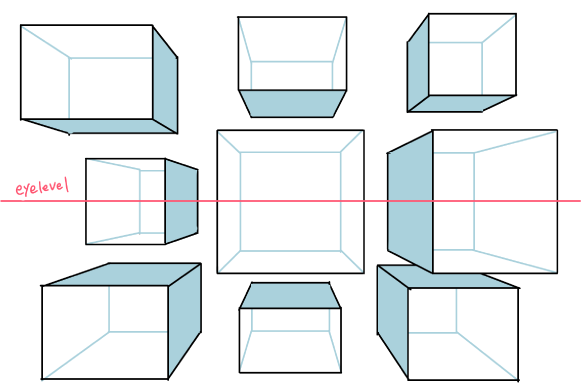
You can use this procedure to draw boxes of various angles, shapes, and sizes. Be sure to draw a lot to get a feel for it.
Draw a box with Two-point perspective

Select the ②[Perspective Array Ruler] from the ①[Ruler Tool]. From Initial Position, select ③[Two-point perspective] in the middle. This time as well, set all ④[Division] except Phase to 1.
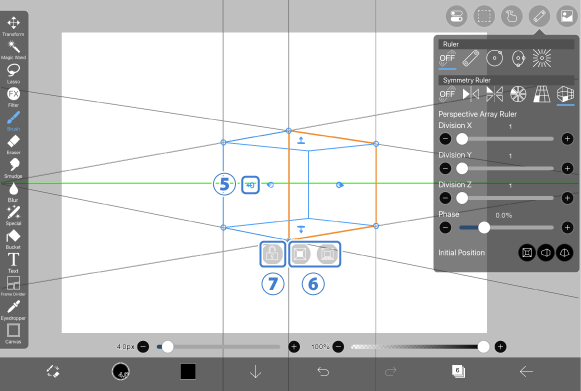
Drag the ⑤[Face knob] to decide the size of the rectangle. The box we will draw this time is facing right, so if you set it to face right with the ⑥[Face Selection button], you will be able to trace the cuboid neatly. Once you have decided on the shape, tap the ⑦[Lock button] to lock the settings of the Perspective Array Ruler.

Draw vertical lines on the Canvas. To do so, select the ⑧[Straight Ruler] from the Ruler Tool. Draw vertical lines along the lines of the Perspective Array Ruler.

Next, place the ⑨[Radial Ruler] at the vanishing point. Select the Ruler Tool from the Ruler Tool and align it with the ⑩[vanishing points].

Since the box we are drawing this time is a Two-point perspective, there are two vanishing points. Select ⑪[Add Radial Ruler] and align the Radial Ruler with ⑫[the other vanishing point].
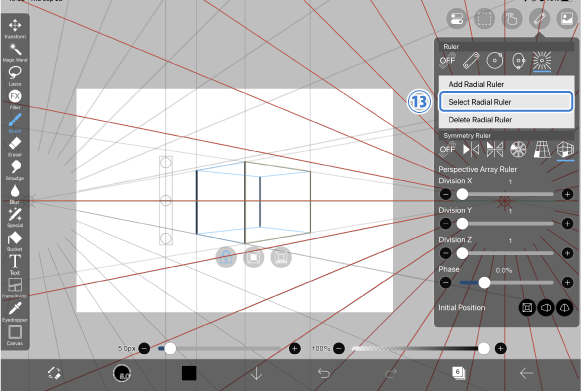
Once you have positioned the Radial Ruler, draw diagonal lines along the perspective lines. You can select the Radial Ruler you want to use from ⑬[Select Radial Ruler].
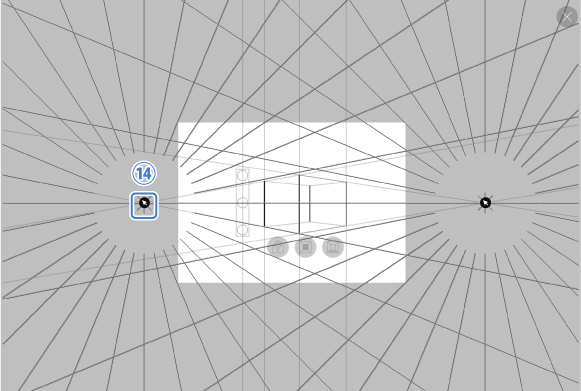
As shown in the image above, the screen for selecting a ruler will appear, so you can switch between them by selecting ⑭[the ruler you want to use]. Switch the ruler according to the direction of the line you want to draw.
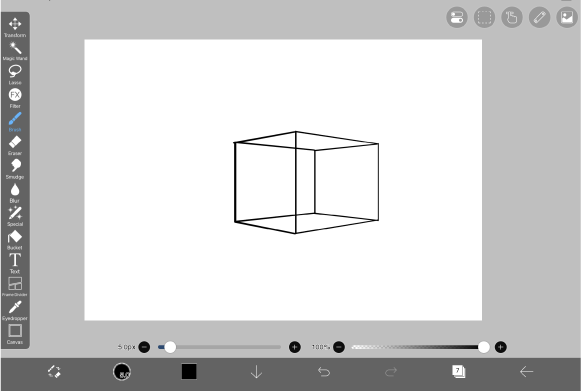
Once you have drawn all the lines, it is completed.
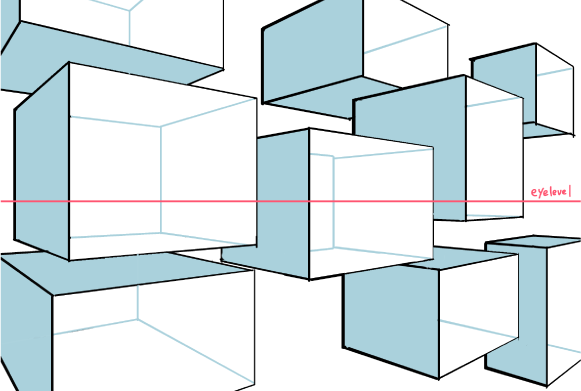
If you apply this method, you will be able to draw backgrounds with a three-dimensional effect.
Draw a box with Three-point perspective
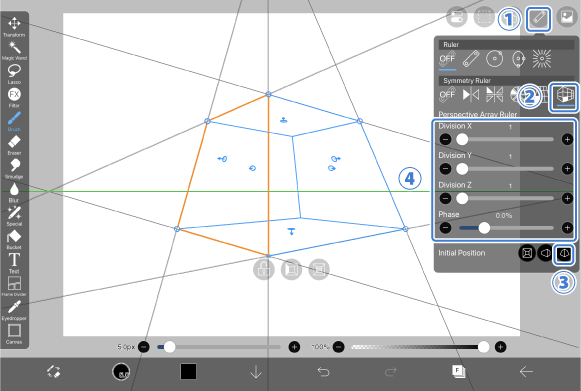
Select the ②[Perspective Array Ruler] from the ①[Ruler Tool]. From Initial Position, select the rightmost ③[Three-point perspective]. Set all ④[Division] other than Phase to 1.
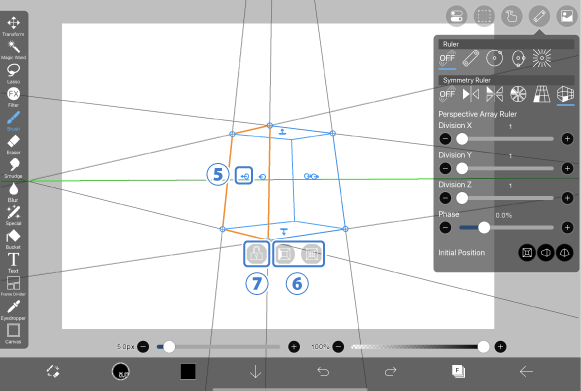
Drag the ⑤[Face knob] to decide the size of the rectangle. The box we will draw this time is facing left, so use the ⑥[Face Selection button] to set it to the left. Once you have decided on the shape, tap the ⑦[Lock button] to lock the settings of the Perspective Array Ruler.

Next, place the Radial Ruler at the vanishing point. Select the ⑧[Radial Ruler] from the Ruler Tool and align it with the ⑨[vanishing points].
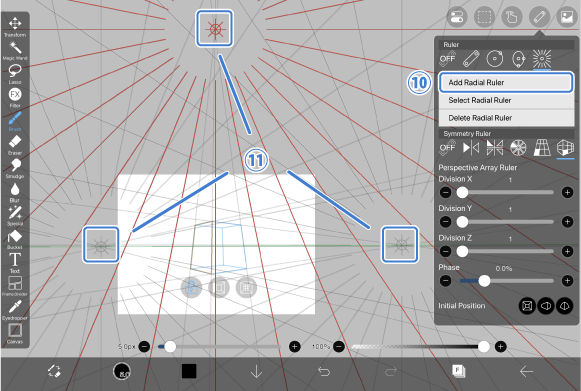
Three-point perspective has three vanishing points, so add two more rulers with ⑩[Add Radial Ruler] and place them at ⑪[the three vanishing points] as shown above.

While switching to the ruler you want to use with ⑫[Select Radial Ruler], trace the guides of the Perspective Array Ruler.
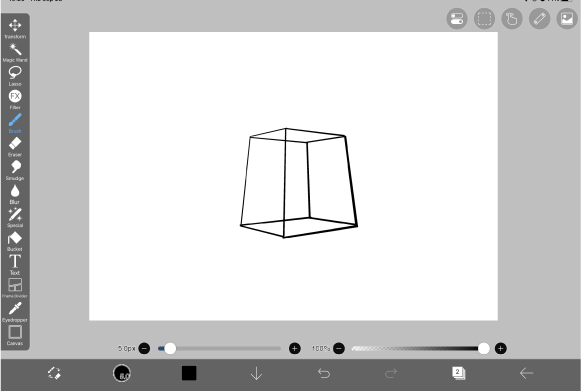
Once you have drawn all the lines, it is completed.

This drawing method can be used when you want to draw a three-dimensional and dynamic background.
This video introduces how to draw backgrounds that can be used in Manga, etc.
Click here for a video of the how to draw backgrounds.
This video introduces how to draw a condominium using Two-point perspective.
Click here for a video of the Perspective Array Ruler
Click here for details on the Perspective Array Ruler
Array Ruler
The Array Ruler is a function where if you draw an illustration on one square of up to 10 x 10 squares, it will be drawn on all squares.
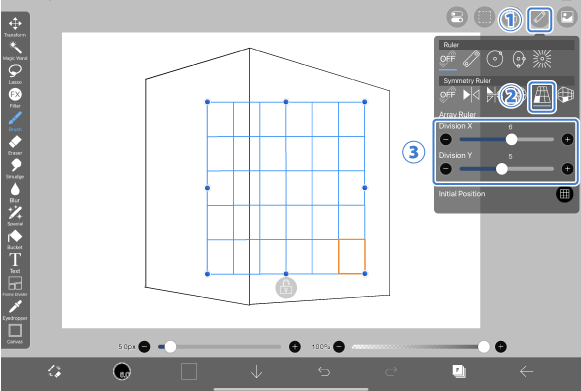
Let’s draw multiple windows in the Two-point perspective box drawn using the Perspective Array Ruler. From the ①[Ruler Tool], select the ②[Array Ruler]. Drag the ③[Division X and Division Y] sliders left and right to adjust the number of divisions. This time, it is set to 6 x 5 squares.
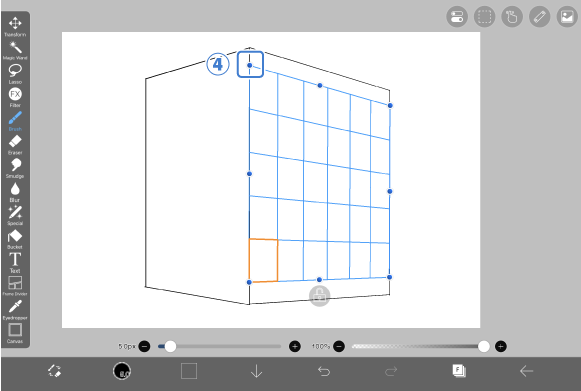
You can add perspective by dragging the ④[Vertex knob].
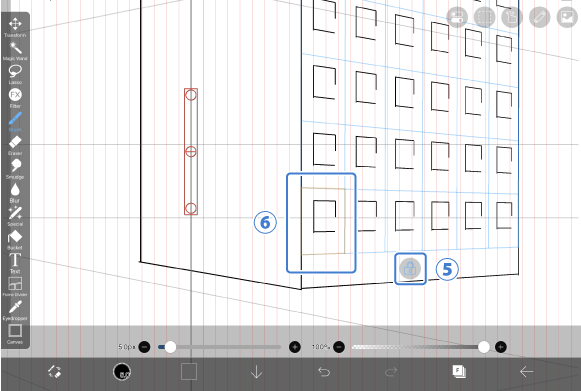
Tap the ⑤[Lock button] and draw in the orange ⑥[Working Cell].
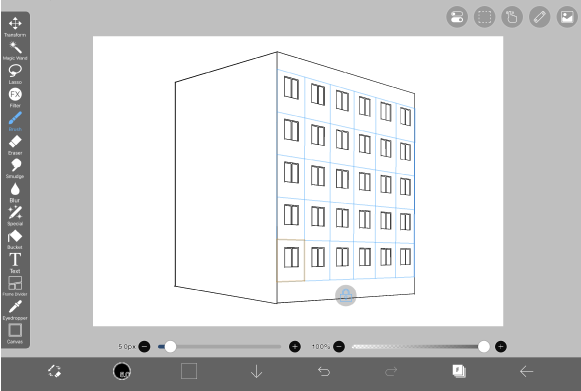
Windows were drawn in all the squares at once.

Since you do not have to draw multiple things one by one, you can improve your work efficiency greatly.
Chapter
-
 01.Introduction
01.Introduction -
 02.Start Creating an Artwork
02.Start Creating an Artwork -
 03.Toolbar and Tool Selection
03.Toolbar and Tool Selection -
 04.Do Your Draft Sketch by Hand
04.Do Your Draft Sketch by Hand -
 05.About Layers
05.About Layers -
 06.Let's Trace
06.Let's Trace -
 07.Undo and Eraser
07.Undo and Eraser -
 08.Fine Tuning Using the Lasso tool
08.Fine Tuning Using the Lasso tool -
 09.Check by Reflecting Horizontally
09.Check by Reflecting Horizontally -
 10.Select Colors in the Color window
10.Select Colors in the Color window -
 11.Use Color Fill for the Undercoat
11.Use Color Fill for the Undercoat -
 12.Turn Clipping On
12.Turn Clipping On -
 13.Making a Gradation (Shading)
13.Making a Gradation (Shading) -
 14.Select a color from the canvas or layer
14.Select a color from the canvas or layer -
 15.Set the Time before Quick Eyedropper Starts
15.Set the Time before Quick Eyedropper Starts -
 16.Create Highlights and Shadows
16.Create Highlights and Shadows -
 17.Paste a Texture
17.Paste a Texture -
 18.Let's Merge Layers
18.Let's Merge Layers -
 19.Sign Your Artwork
19.Sign Your Artwork -
 20.View Your Artwork
20.View Your Artwork -
 21.Post Your Artwork
21.Post Your Artwork -
 22.Share Your Artwork
22.Share Your Artwork -
 23.Open your ibisPaint data in Clip Studio Paint
23.Open your ibisPaint data in Clip Studio Paint -
 24.Prime Membership / Remove Ads Add-on (for iPhone/iPad, Android)
24.Prime Membership / Remove Ads Add-on (for iPhone/iPad, Android) -
 25.Prime Membership / Pro Add-on (for Windows, Mac)
25.Prime Membership / Pro Add-on (for Windows, Mac) -
 26.Synchronizing the artworks on your device with Cloud Storage
26.Synchronizing the artworks on your device with Cloud Storage -
 27.Save the past state of an Artwork as an IPV file
27.Save the past state of an Artwork as an IPV file -
 28.Rearrange artworks
28.Rearrange artworks -
 29.Artworks Folder Feature
29.Artworks Folder Feature -
 30.Make custom brush
30.Make custom brush -
 31.Create Original Brush Patterns
31.Create Original Brush Patterns -
 32.Installing and Exporting the Custom Brush
32.Installing and Exporting the Custom Brush -
 33.Release a Custom Brush to the Online Gallery
33.Release a Custom Brush to the Online Gallery -
 34.Brush Export and Import
34.Brush Export and Import -
 35.Search For Brushes
35.Search For Brushes -
 36.Display images to use as reference
36.Display images to use as reference -
 37.Add Color to the Analog Image using Multiply
37.Add Color to the Analog Image using Multiply -
 38.Stabilizer
38.Stabilizer -
 39.Layer: Clipping is convenient
39.Layer: Clipping is convenient -
 40.Layer: Changing the color with Alpha Lock
40.Layer: Changing the color with Alpha Lock -
 41.Layer: Let's try using Screen Tone
41.Layer: Let's try using Screen Tone -
 42.Layer: Selection Layer
42.Layer: Selection Layer -
 43.Layer: Save Layer as Transparent PNG command
43.Layer: Save Layer as Transparent PNG command -
 44.Layer: Naming your layers to manage them
44.Layer: Naming your layers to manage them -
 45.Layer: Rasterize
45.Layer: Rasterize -
 46.Layer: Layer Folders
46.Layer: Layer Folders -
 47.Layer: Folder Move/Transform
47.Layer: Folder Move/Transform -
 48.Layer: Add Layer from Canvas
48.Layer: Add Layer from Canvas -
 49.Vector Layer
49.Vector Layer -
 50.How to edit a brush shape
50.How to edit a brush shape -
 51.Contents Layer Selection
51.Contents Layer Selection -
 52.Apply Canvas Papers to your canvas
52.Apply Canvas Papers to your canvas -
 53.Display Grid on the Canvas
53.Display Grid on the Canvas -
 54.Save canvas as Transparent PNG
54.Save canvas as Transparent PNG -
 55.Make the background transparent with Eraser Bucket
55.Make the background transparent with Eraser Bucket -
 56.Bucket Tool: Surrounding Fill / Surrounding Eraser
56.Bucket Tool: Surrounding Fill / Surrounding Eraser -
 57.Putting texture to the floor with Perspective Form
57.Putting texture to the floor with Perspective Form -
 58.Skirt with Mesh Form
58.Skirt with Mesh Form -
 59.Entering text with Text tool
59.Entering text with Text tool -
 60.Creating manga with Frame Divider tool
60.Creating manga with Frame Divider tool -
 61.Enlarging the canvas with Canvas Size
61.Enlarging the canvas with Canvas Size -
 62.Cutting off the canvas with Trim
62.Cutting off the canvas with Trim -
 63.Create a Manga Manuscript for Printing
63.Create a Manga Manuscript for Printing -
 64.Canvas creation with resolution (dpi) specification
64.Canvas creation with resolution (dpi) specification -
 65.Changing image resolution with Resize
65.Changing image resolution with Resize -
 66.Change canvas Color Mode
66.Change canvas Color Mode -
 67.Output High-Resolution Images with AI (Artificial Intelligence)
67.Output High-Resolution Images with AI (Artificial Intelligence) -
 68.AI Disturbance
68.AI Disturbance -
 69.Texture with Material tool
69.Texture with Material tool -
 70.Cut, Copy, Paste
70.Cut, Copy, Paste -
 71.Ruler: Straight Ruler
71.Ruler: Straight Ruler -
 72.Ruler: Circular Ruler
72.Ruler: Circular Ruler -
 73.Ruler: Elliptical Ruler
73.Ruler: Elliptical Ruler -
 74.Ruler: Radial Ruler
74.Ruler: Radial Ruler -
 75.Ruler: Mirror Ruler
75.Ruler: Mirror Ruler -
 76.Ruler: Kaleidoscope Ruler
76.Ruler: Kaleidoscope Ruler -
 77.Ruler: Array Ruler
77.Ruler: Array Ruler -
 78.Ruler: Perspective Array Ruler
78.Ruler: Perspective Array Ruler -
 79.Drawing Tool: Straight Line
79.Drawing Tool: Straight Line -
 80.Drawing Tool: Rectangle
80.Drawing Tool: Rectangle -
 81.Drawing Tool:Circle
81.Drawing Tool:Circle -
 82.Drawing Tool:Ellipse
82.Drawing Tool:Ellipse -
 83.Drawing Tool:Regular Polygon
83.Drawing Tool:Regular Polygon -
 84.Drawing Tool:Bezier Curve
84.Drawing Tool:Bezier Curve -
 85.Drawing Tool:Polyline
85.Drawing Tool:Polyline -
 86.Drawing Tool:Fill
86.Drawing Tool:Fill -
 87.Selection Area tool: Color Range
87.Selection Area tool: Color Range -
 88.Selection Area tool: Expand/Contract Selection Area
88.Selection Area tool: Expand/Contract Selection Area -
 89.Special: Liquify Pen
89.Special: Liquify Pen -
 90.Special: Lasso Fill
90.Special: Lasso Fill -
 91.Special: Lasso Eraser
91.Special: Lasso Eraser -
 92.Special: Copy Pen
92.Special: Copy Pen -
 93.Filter (Adjust Color): Brightness & Contrast
93.Filter (Adjust Color): Brightness & Contrast -
 94.Filter (Adjust Color): Tone Curve
94.Filter (Adjust Color): Tone Curve -
 95.Filter (Adjust Color): Hue Saturation Lightness
95.Filter (Adjust Color): Hue Saturation Lightness -
 96.Filter (Adjust Color): Color Balance
96.Filter (Adjust Color): Color Balance -
 97.Filter (Adjust Color): Extract Line Drawing
97.Filter (Adjust Color): Extract Line Drawing -
 98.Filter (Adjust Color): Find Edges (Handwriting)
98.Filter (Adjust Color): Find Edges (Handwriting) -
 99.Filter (Adjust Color): Find Edges
99.Filter (Adjust Color): Find Edges -
 100.Filter (Adjust Color): Change Drawing Color
100.Filter (Adjust Color): Change Drawing Color -
 101.Filter (Adjust Color): Mono Color
101.Filter (Adjust Color): Mono Color -
 102.Filter (Adjust Color): Grayscale
102.Filter (Adjust Color): Grayscale -
 103.Filter (Adjust Color): Black & White
103.Filter (Adjust Color): Black & White -
 104.Filter (Adjust Color): Posterize
104.Filter (Adjust Color): Posterize -
 105.Filter (Adjust Color): Invert Color
105.Filter (Adjust Color): Invert Color -
 106.Filter (Adjust Color): Gradation Map
106.Filter (Adjust Color): Gradation Map -
 107.Filter (Adjust Color): Levels Adjustment
107.Filter (Adjust Color): Levels Adjustment -
 108.Filter (Adjust Color): Replace Color
108.Filter (Adjust Color): Replace Color -
 109.Filter (Blur): Gaussian Blur
109.Filter (Blur): Gaussian Blur -
 110.Filter (Blur): Zooming Blur
110.Filter (Blur): Zooming Blur -
 111.Filter (Blur): Moving Blur
111.Filter (Blur): Moving Blur -
 112.Filter (Blur):Spin Blur
112.Filter (Blur):Spin Blur -
 113.Filter (Blur): Lens Blur
113.Filter (Blur): Lens Blur -
 114.Filter (Blur): Mosaic
114.Filter (Blur): Mosaic -
 115.Filter (Blur): Unsharp Mask
115.Filter (Blur): Unsharp Mask -
 116.Filter (Blur): Frosted Glass
116.Filter (Blur): Frosted Glass -
 117.Filter (Style): Stroke (Both)
117.Filter (Style): Stroke (Both) -
 118.Filter (Style): Stained Glass
118.Filter (Style): Stained Glass -
 119.Filter (Style): Wet Edge
119.Filter (Style): Wet Edge -
 120.Filter (Style): Glow (Inner)
120.Filter (Style): Glow (Inner) -
 121.Filter (Style): Bevel (Inner)
121.Filter (Style): Bevel (Inner) -
 122.Filter (Style): Bevel (Outer)
122.Filter (Style): Bevel (Outer) -
 123.Filter (Style): Emboss
123.Filter (Style): Emboss -
 124.Filter (Style): Relief
124.Filter (Style): Relief -
 125.Filter (Style): Waterdrop (Rounded)
125.Filter (Style): Waterdrop (Rounded) -
 126.Filter (Style): Stroke (Outer)
126.Filter (Style): Stroke (Outer) -
 127.Filter (Style): Glow (Outer)
127.Filter (Style): Glow (Outer) -
 128.Filter (Style): Satin
128.Filter (Style): Satin -
 129.Filter (Style): Drop Shadow
129.Filter (Style): Drop Shadow -
 130.Filter (Style): Extrude
130.Filter (Style): Extrude -
 131.Filter (Style): God Rays
131.Filter (Style): God Rays -
 132.Filter (Draw): Parallel Gradation
132.Filter (Draw): Parallel Gradation -
 133.Filter (Draw): Concentric Gradation
133.Filter (Draw): Concentric Gradation -
 134.Filter (Draw): Radial Line Gradation
134.Filter (Draw): Radial Line Gradation -
 135.Filter (Draw): Radial Line
135.Filter (Draw): Radial Line -
 136.Filter (Draw): Speed Line
136.Filter (Draw): Speed Line -
 137.Filter (Draw): Clouds
137.Filter (Draw): Clouds -
 138.Filter (Draw): QR Code
138.Filter (Draw): QR Code -
 139.Filter (AI): Watercolor Filter
139.Filter (AI): Watercolor Filter -
 140.Filter (AI): Background Removal
140.Filter (AI): Background Removal -
 141.Filter (Artistic): Anime Background
141.Filter (Artistic): Anime Background -
 142.Filter (Artistic): Manga Background
142.Filter (Artistic): Manga Background -
 143.Filter (Artistic): Chromatic Aberration (Color Shift, RGB Shift)
143.Filter (Artistic): Chromatic Aberration (Color Shift, RGB Shift) -
 144.Filter (Artistic): Glitch
144.Filter (Artistic): Glitch -
 145.Filter (Artistic): Noise
145.Filter (Artistic): Noise -
 146.Filter (Artistic): Retro Game
146.Filter (Artistic): Retro Game -
 147.Filter (Artistic): Chrome
147.Filter (Artistic): Chrome -
 148.Filter (Artistic): Bloom
148.Filter (Artistic): Bloom -
 149.Filter (Artistic): Cross Filter
149.Filter (Artistic): Cross Filter -
 150.Filter (Artistic): Sheer
150.Filter (Artistic): Sheer -
 151.Filter (Pixelate): Pixelate Crystalize
151.Filter (Pixelate): Pixelate Crystalize -
 152.Filter (Pixelate): Hexagonal Pixelate
152.Filter (Pixelate): Hexagonal Pixelate -
 153.Filter (Pixelate): Square Pixelate
153.Filter (Pixelate): Square Pixelate -
 154.Filter (Pixelate): Triangular Pixelate
154.Filter (Pixelate): Triangular Pixelate -
 155.Filter (Pixelate): Pointillize
155.Filter (Pixelate): Pointillize -
 156.Filter (Pixelate): Dots (Hexagonal)
156.Filter (Pixelate): Dots (Hexagonal) -
 157.Filter (Pixelate): Dots (Square)
157.Filter (Pixelate): Dots (Square) -
 158.Filter (Transform): Expansion
158.Filter (Transform): Expansion -
 159.Filter (Transform): Fisheye Lens
159.Filter (Transform): Fisheye Lens -
 160.Filter (Transform): Sphere Lens
160.Filter (Transform): Sphere Lens -
 161.Filter (Transform): Wave
161.Filter (Transform): Wave -
 162.Filter (Transform): Ripple
162.Filter (Transform): Ripple -
 163.Filter (Transform): Twirl
163.Filter (Transform): Twirl -
 164.Filter (Transform): Polar Coordinates
164.Filter (Transform): Polar Coordinates -
 165.Filter (Frame): Table
165.Filter (Frame): Table -
 166.Filter (Frame): Blur Frame
166.Filter (Frame): Blur Frame -
 167.Filter (Movie): Rain
167.Filter (Movie): Rain -
 168.Adjustment Layer
168.Adjustment Layer -
 169.Create an animation
169.Create an animation -
 170.Manga Function: Let's create a manga manuscript
170.Manga Function: Let's create a manga manuscript -
 171.Manga Function: Master the Manga creation tools
171.Manga Function: Master the Manga creation tools -
 172.Manga Function: Make Use of Materials
172.Manga Function: Make Use of Materials -
 173.Manga Function: Publishing and Printing your Manga
173.Manga Function: Publishing and Printing your Manga -
 174.Switching devices / transferring data (with Dropbox)
174.Switching devices / transferring data (with Dropbox) -
 175.Switching devices / transferring data (with SD card on Android)
175.Switching devices / transferring data (with SD card on Android) -
 176.Switching devices / transferring data (with PC on iOS)
176.Switching devices / transferring data (with PC on iOS) -
 177.Model change / Transfer (Backup settings)
177.Model change / Transfer (Backup settings) -
 178.Settings window details
178.Settings window details -
 179.Change the Background Color of the Canvas
179.Change the Background Color of the Canvas -
 180.Details of Brush Parameters
180.Details of Brush Parameters -
 181.Bucket tool details
181.Bucket tool details -
 182.Layer Window Details
182.Layer Window Details -
 183.Transform tool details
183.Transform tool details -
 184.Blend mode details
184.Blend mode details -
 185.View Menu details
185.View Menu details -
 186.How to upload transparent PNG onto X
186.How to upload transparent PNG onto X -
 187.Importing and exporting Photoshop files (PSD)
187.Importing and exporting Photoshop files (PSD) -
 188.Posting Multiple Pages of Comic to the Online Gallery
188.Posting Multiple Pages of Comic to the Online Gallery -
 189.Gestures, Keyboard shortcuts (iOS,iPadOS,Android versions)
189.Gestures, Keyboard shortcuts (iOS,iPadOS,Android versions) -
 190.Gestures, Keyboard shortcuts (Windows Version)
190.Gestures, Keyboard shortcuts (Windows Version) -
 191.Display a Crosshair Symbol When Hovering the Stylus Pen
191.Display a Crosshair Symbol When Hovering the Stylus Pen -
 192.Set Up Palm Rejection
192.Set Up Palm Rejection -
 193.Use a Promo Code
193.Use a Promo Code -
 194.Delete Account
194.Delete Account
